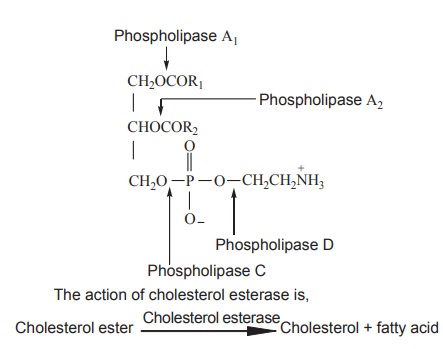Chapter: Biochemistry: Digestion
Digestion of Lipids
Digestion of Lipids
As all the enzymes involved in digestion are
water soluble, lipids pose a special problem due to their insoluble nature. The
problem of fat digestion is solved by emulsification of fats (i.e). breaking of
large fat particles to small particles such that there is an increase in the
surface area, which facilitates the interaction of fats with the fat
hydrolyzing enzyme lipase.
Dietary sources of fat are from animal as well
as vegetable origin. Animal sources include dairy products like milk, butter,
ghee, meat, pork, eggs and fish. Vegetable sources include various cooking
oils. Vegetables sources are superior to animal sources because of the presence
of the various polyunsaturated fatty acids.
1. Digestion in mouth
Recently, a lingual lipase has been detected in
mouth. Its optimum pH is 4 to 4.5. It acts on the food in the stomach, where it
resides for some time. Lingual lipase is best suited to act on milk.
2. Digestion in stomach
Gastric lipase acts on triglycerides to some
extent only because,
o no emulsification of fats takes place in the
stomach.
o the quantity of enzyme present is very low.
o it has an optimum activity at pH 7.8
Satiety value
Fats delay the rate of emptying of stomach, by
inhibiting the gastric motility via the hormone enterogastrone. Thus they have
a high satiety value (fillingness of the stomach).
3. Digestion in duodenum and small intestine
The digestion of fats takes place mainly in the
duodenum and small intestine because of the presence of powerful enzyme lipase
in the pancreatic juice and emulsification of fats by the bile salts.
Pancreatic lipase is called as steapsin and it
acts on the triglycerides present in the diet. It has an optimum pH at the
alkaline range.
The action of lipase on triglycerides occurs by
the following steps.
·
Conversion
of triglyceride to α, β diglyceride by removal of the terminal fatty acid.
·
Removal
of a fatty acid to produce b monoglyceride.
·
β
monoglycerides are not acted upon by lipases, so they are isomerized to a
monoglyceride.
·
Complete
hydrolysis of a monoglyceride to free fatty acid and glycerol.
The other enzymes present in pancreatic juice
are phospholipases and cholesterol esterase.
There are four different phosopholipases that
can cleave phospholipids to glycerol, free fatty acids, phosphoric acid and the
base. They are phospholipase A1, phospholipase A2,
phospholipase C and phospholipase D. The site of actions of phospholipases are
as follows.

4. Absorption of fats
·
Free
fatty acids are absorbed by the absorptive cells of the intestinal walls by
simple diffusion. As the entering fatty acids are rapidly converted to
triglycerides, the above process is speeded up.
·
A
part of glycerol and short chain fatty acids are directly absorbed by the portal
circulation and taken to the liver.
·
Glycerol
and fatty acids that enter to the intestinal epithelial cells are converted to
triglycerides and in the lacteals, they are covered with a layer of hydrophilic
phospholipids, cholesterol, cholesterol esters and an apoprotein apo B. After
being packaged to a more hydrophilic soluble form, they enter into the
lymphatic circulation and finally enters the systemic circulation via the
thoracic duct.
6. Factors affecting absorption
·
Short
chain fatty acids are absorbed at a faster rate than long chain fatty acids.
They also enhance the absorption of long chain fatty acids.
·
Plant
sterols like stigmasterol and sitosterol inhibit cholesterol absorption.
·
Bile
salts enhance the digestion of fats. Absence of bile in jaundice reduces the
digestion of fats.
·
Absorption
of cholesterol is facilitated by unsaturated fatty acids and bile salts.
Related Topics